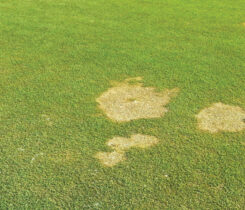Mike Kenna, Ph.D., shares a timeline of the USGA’s water history
Water management on golf courses has been a topic of research and discussion for several decades. The challenges golf facilities face today are not entirely new, sharing similarities with those experienced in the past. The USGA Green Section timeline provides a historical perspective on the evolution of water use in golf since 1931.

(Photo: CT757fan/E+/Getty Images)
In the 1930s, the USGA was already exploring the issue of watering turf. Articles recommended the installation and use of fairway sprinklers. As golf courses started to incorporate more turf, the delicate question of water management arose.
Moving into the 1950s, the importance of water conservation began to gain attention. Golf courses recognized the need to save water and reduce maintenance under government control.
The 1960s witnessed advancements in irrigation technology. Automatic irrigation systems emerged, shifting the focus towards conservation and efficient water use. Golf courses started to explore the concept of water management and the potential benefits of irrigation systems.
Environmental challenges
Water conservation continued to be a priority in the 1970s. The drought in Northern California emphasized the need for efficient water use on golf courses. East of the Mississippi River, Oakland Hills Country Club in Bloomfield Hills, Mich., implemented water conservation measures, demonstrating the industry’s commitment to responsible water management.
The 1980s brought a deeper understanding of water conservation and its long-term implications. Discussions revolved around coping with salty water, the efficient use of this natural resource and the relationship between water use and energy consumption.
The 1990s saw an increased focus on the environmental aspects of water management. Golf courses like Ozaukee Country Club in Mequon, Wis., used Audubon certifications as stepping stones to improve the environment.
Water management remained a critical issue in the 2000s. Making every drop count became a mantra for golf courses. Water regulators and the golf industry worked together on mapping the direction for regulating water use.
Significant progress
The 2010s marked significant progress in water management strategies. The USGA continued to play a pivotal role by funding research to reduce water use. Developing water budgets became an essential aspect of golf course management. The USGA Water Resource Center provides a digital information collection to document golf’s water use. Water summits successfully brought together industry professionals to discuss and address water-related challenges.
Recently, the focus has shifted to getting ahead of water regulations. Courses are encouraged to engage in water discussions and implement conservation strategies. The goal is to show the industry’s commitment to responsible water use and conservation.
The timeline highlights the ongoing efforts to address water management on golf courses. Strategies to reduce water inputs and promote sustainability include updating irrigation systems, optimizing flow and pressure and using wetting agents and growth regulators.
Eliminating overseeding, condensing the overseeding period and implementing in-ground soil moisture sensors can contribute to water savings. Turf reduction and conversion from cool- to warm-season grasses are advanced techniques offering substantial water savings.
The industry recognizes the desire to change the narrative around golfer expectations regarding turf quality and playing conditions. By managing these expectations and promoting a culture of water conservation, golf courses can further contribute to water sustainability efforts.
Courses engage with water authorities proactively and implement conservation strategies. This highlights their commitment to water conservation and contributes to a more sustainable future for the sport.












